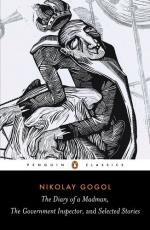|
This section contains 298 words (approx. 1 page at 400 words per page) |

|
The Government Inspector Summary & Study Guide Description
The Government Inspector Summary & Study Guide includes comprehensive information and analysis to help you understand the book. This study guide contains the following sections:
This detailed literature summary also contains Bibliography and a Free Quiz on The Government Inspector by Nikolai Gogol.
The Government Inspector, by Nikolai Gogol, has also been translated into English under the titles The Inspector General, and The Inspector. The written play was brought to the attention of the Tsar Nicholas I, who liked it so much that he insisted on its production. The Government Inspector premiered at the Alexandrinsky Theatre, in Saint Petersburg, in 1836. The tsar, who was among the first to see the play, was said to have commented that the play ridiculed everyone—most of all himself.
The plot of The Government Inspector hinges on a case of mistaken identity, when a lowly impoverished young civil servant from Saint Petersburg, Hlestakov, is mistaken by the members of a small provincial town for a high-ranking government inspector. The town's governor, as well as the leading government officials, fear the consequences of a visit by a government inspector, should he observe the extent of their corruption. Hlestakov makes the most of this misconception, weaving elaborate tales of his life as a high-ranking government official and accepting generous bribes from the town officials. After insincerely proposing to the governor's daughter, Hlestakov flees before his true identity is discovered. The townspeople do not discover their mistake until after he is long gone and moments before the announcement of the arrival of the real government inspector.
The Government Inspector ridicules the extensive bureaucracy of the Russian government under the tsar as a thoroughly corrupt system. Universal themes of human corruption and the folly of self-deception are explored through this drama of Russian life. The governor's famous line, as he turns to address the audience directly, "What are you laughing at? You are laughing at yourselves," illustrates this theme, which is summed up in the play's epigraph, "If your face is crooked, don't blame the mirror."
Read more from the Study Guide
|
This section contains 298 words (approx. 1 page at 400 words per page) |

|



